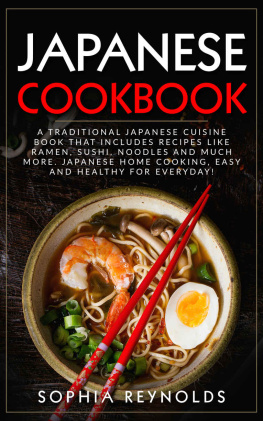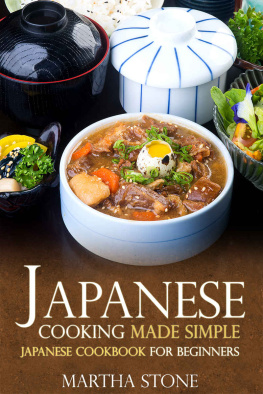Stone - Japanese Cookbook: The Traditional and Simple Japanese Cuisine
Here you can read online Stone - Japanese Cookbook: The Traditional and Simple Japanese Cuisine full text of the book (entire story) in english for free. Download pdf and epub, get meaning, cover and reviews about this ebook. year: 2015, genre: Home and family. Description of the work, (preface) as well as reviews are available. Best literature library LitArk.com created for fans of good reading and offers a wide selection of genres:
Romance novel
Science fiction
Adventure
Detective
Science
History
Home and family
Prose
Art
Politics
Computer
Non-fiction
Religion
Business
Children
Humor
Choose a favorite category and find really read worthwhile books. Enjoy immersion in the world of imagination, feel the emotions of the characters or learn something new for yourself, make an fascinating discovery.
- Book:Japanese Cookbook: The Traditional and Simple Japanese Cuisine
- Author:
- Genre:
- Year:2015
- Rating:5 / 5
- Favourites:Add to favourites
- Your mark:
- 100
- 1
- 2
- 3
- 4
- 5
Japanese Cookbook: The Traditional and Simple Japanese Cuisine: summary, description and annotation
We offer to read an annotation, description, summary or preface (depends on what the author of the book "Japanese Cookbook: The Traditional and Simple Japanese Cuisine" wrote himself). If you haven't found the necessary information about the book — write in the comments, we will try to find it.
Japanese Cookbook: The Traditional and Simple Japanese Cuisine — read online for free the complete book (whole text) full work
Below is the text of the book, divided by pages. System saving the place of the last page read, allows you to conveniently read the book "Japanese Cookbook: The Traditional and Simple Japanese Cuisine" online for free, without having to search again every time where you left off. Put a bookmark, and you can go to the page where you finished reading at any time.
Font size:
Interval:
Bookmark:
Japanese Cookbook
The Traditional and Simple Japanese Cuisine
By
Martha Stone
Copyright 2015 Martha Stone
Kindle Edition

License Notes
No part of this Book can be reproduced in any form or by any means including print, electronic, scanning or photocopying unless prior permission is granted by the author.
All ideas, suggestions and guidelines mentioned here are written for informative purposes. While the author has taken every possible step to ensure accuracy, all readers are advised to follow information at their own risk. The author cannot be held responsible for personal and/or commercial damages in case of misinterpreting and misunderstanding any part of this Book.
About the author

Martha Stone is a chef and also cookbook writer. She was born and raised in Idaho where she spent most of her life growing up. Growing up in the country taught her how to appreciate and also use fresh ingredients in her cooking. This love for using the freshest ingredients turned into a passion for cooking. Martha loves to teach others how to cook and she loves every aspect of cooking from preparing the dish to smelling it cooking and sharing it with friends.
Martha eventually moved to California and met the love of her life. She settled down and has two children. She is a stay at home mom and involves her children in her cooking as much as possible. Martha decided to start writing cookbooks so that she could share her love for food and cooking with everyone else.
For a complete list of my published books, please, visit my Author's Page...
http://www.amazon.com/Martha-Stone/e/B00FDU8GR6/
You can also check out my blog at: http://martha-stone.blogspot.com or my Facebook at: https://www.facebook.com/marthastone2013
Table of Contents
Introduction
In this cookbook, 25 simple recipes for traditional Japanese dishes and some international dishes with the Japanese twist which can be easily prepared are given. So anybody can easily begin to love Japanese food. Everybody have their own traditions of eating, but if one adds few Japanese recipes, their experience and knowledge about cooking will expand. Especially this book is very useful for beginners. To enjoy cooking the Japanese food, let us explore into the world of Traditional Japanese Cuisine!
1) Ginger Tea
The Japanese version of the ginger tea is known as Shogayu, which is used as a natural remedy for treating common cold. This spicy and soothing herbal tea surely warms up our body in the cold season.
Prep Time: 5 minutes
Cook Time: 5 minutes
Yields: 2 servings
Ingredients:
- 2 teaspoons of grated ginger root
- 3 tablespoons of honey
- 1 cups of water
- 2 teaspoons of cornstarch or potato starch (Katakuriko) plus 2 teaspoons of water
Instructions:
1. Grate the ginger.
2. In a vessel, add ginger, water, and honey; place it over medium heat till just prior to boiling.
3. Mix well 2 teaspoons of water and potato starch in a bowl. Add this paste to tea; stir well. Heat for about 1 to 2 minutes till it becomes a little bit thick.
2) Herring Roe Dish
In Japan, the salty herring-roe marinated in the seasoned fish broth is known as Kazunoko.
Ingredients:
- cup of fish broth
- 4 to 5 herring roe (Kazunoko)
- 1 tablespoons of soy sauce
- Dry bonito flakes (Katsuobushi)
- 1 tablespoon of rice-wine
Instructions:
1. Desalinate the herring roe by soaking it in salt water for overnight in refrigerator (8 to 12 hours). Remove the membrane.
2. Place fish broth, rice-wine and soy sauce in a pan; bring it to a boil and then cool. Keep it aside.
3. Marinate the prepared herring roe for overnight in the seasoned fish broth in refrigerator.
4. Tear the herring roe into bite-sized pieces; serve it with dry bonito flakes over the top.
3) Sugar and Soy Sauce Glazed Sardines
In Japan, this recipe is known as Tazukuri, tiny dried sardines (Gomame) that is cooked in soy sauce and sugar.
Ingredients:
- 1 oz of small dried sardines (Gomame)
- 1 tablespoons of soy sauce
- 2 tablespoons of sugar
Instructions:
1. In a pan, fry the sardines over medium-low heat for about 1 to 2 minutes, till the fish turns brown slightly. Spread them on a platter and allow them to cool.
2. In a fry pan, add soy sauce and sugar; cook over low heat till the bubbles become small and still its texture is loose. Add the sardines; coat it with sauce.
3. Immediately spread it on a platter and cool.
4) Roasted Pork
Roasted pork in Japan is called Yakibuta. It is similar to a China recipe called Cha-Siu. While Cha-Siu uses several spices like cinnamon, star anise and honey to give flavour to the meat, this Japanese recipe is much simpler to taste. This is used as a topping for the Ramen. It is very simple and easy to prepare at home!
Ingredients:
- 2 lb of pork shoulder butt
- cup of rice-wine
- cup of soy sauce
- cup of sugar
- 1 clove garlic
- 4-5 thick ginger root slices
Instructions:
1. Tie the pork meat at intervals of 1-inch using a cotton string.
2. Place all ingredients together with meat in one bag and close; marinade it in fridge for a minimum of 4-5 hours or overnight if possible.
3. Preheat oven at 350F (175C); bake it for 1 hour, turn and baste 1 or 2 times in between.
4. Take out the meat from oven and allow it to stand for about 30 minutes; remove the tied strings; cut the meat into slices.
5) Miso Soup with Pork and Vegetables
In Japan, this recipe is called Tonjiru, one type of Miso-Soup made with the pork and lots of root-vegetables such as carrot and burdock. Although it is one type of Miso-soup, Tonjiru tastes extremely different from the ordinary Miso-Soup. It has a distinct pork-flavour and a strong taste from the Gobo.
Ingredients:
- 1/5 lb of pork, sliced thinly
- Approximately 15 cm burdock
- carrot
- of 1 Konnyaku block
- Approximately 5cm Radish
- 2 green onions
- 3 tablespoon of Miso Paste
- 3 cups of fish broth
Instructions:
1. Cut the pork into tiny pieces. Cut radish and carrot length wise into quarters and then finely slice. Thinly shave the burdock. Cut the Konnyaku block into thin slices of 2-inch long. And cut the onions into 1/4 -inch pieces.
2. Boil the fish broth in a pan; add burdock, radish, carrot and Konnyaku; cook over medium heat till the vegetables become tender.
3. Turn the heat to down; add meat. Once the meat changes its color, add the Miso paste to it and stir. Then add onion; serve.
6) Fried Burdock and Carrot
This braised carrot and burdock root in a salty and sweet sauce is popularly known as Kinpira Gobo in Japan. Its name Kinpira came from the famous muscleman and it illustrates how nutritious this dish is.
Prep Time: 15 minutes
Cook Time: 10 minutes
Yields: 4 servings
Ingredients:
- 1 carrot, cut thinly
- 1 burdock, Sasagaki cut
- cup of fish broth (or water)
- 1 tablespoon of oil
- 2 tablespoons of Soy Sauce
Font size:
Interval:
Bookmark:
Similar books «Japanese Cookbook: The Traditional and Simple Japanese Cuisine»
Look at similar books to Japanese Cookbook: The Traditional and Simple Japanese Cuisine. We have selected literature similar in name and meaning in the hope of providing readers with more options to find new, interesting, not yet read works.
Discussion, reviews of the book Japanese Cookbook: The Traditional and Simple Japanese Cuisine and just readers' own opinions. Leave your comments, write what you think about the work, its meaning or the main characters. Specify what exactly you liked and what you didn't like, and why you think so.














![Miyoko Nishimoto Schinner - Japanese Cooking: Contemporary & Traditional [Simple, Delicious, and Vegan]](/uploads/posts/book/41405/thumbs/miyoko-nishimoto-schinner-japanese-cooking.jpg)